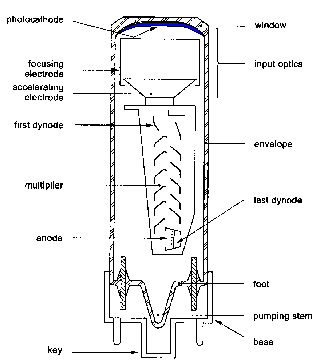In a conventional photomultiplier tube (PMT) the electron emitted from the cathode is accelerated towards a structure of dynodes. The dynodes are made of a material wiyh high secondary electron emission coefficient d. On average, an incident electron gives rise to the emission of d secondary electrons, where d is of the order 3 - 10.. A chain of n dynodes will therefore multiply the original photoelectron by a factor
G = d ^ n
For each of the steps the actual number of emitted secondaries is however Poisson distributed. The relative fluctuations are of course largest for the first dynodes, where the number of electrons is still very small. This is the reason for the poor energy resolution of a PMT. The situation can only be improved by using fancy dynode materials with high d values.

Schematics of a conventional photomultiplier tube
Simulation of a pulse height spectrum for a PMT with a very high d-value ( d = 25).
For some more information click here
